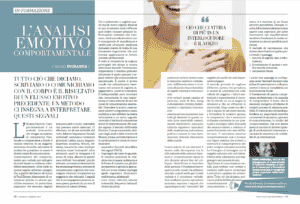
Companies to the test of happiness
6 December 2019
Companies for a smile
5 February 2020ENHANCING EMOTIONAL COMPETENCE AT WORK

Rubric “PSYCHOLOGY OF EMOTIONS” by Diego Ingrassia – “MANAGEMENT AND MANAGEMENT OF EMOTIONS”
for PSICOLOGIA CONTEMPORANEA – Addictions – no. 273, May-June 2019 – GIUNTI EDITORE
Today, ORGANISATIONS TAKE INTO GREATER CONSIDERATION THE MOTIVATION AND EMOTIONAL INTELLIGENCE OF THE EMPLOYER
Those who follow the world of training will probably remember that, starting in the early 1990s, the need began to be felt for tools that could interpret work performance beyond its technical-specialist component.
At a certain point, it was realised that in order to achieve a high level of performance, in a world that was becoming more and more complex day by day, the ‘human factor’ had become an indispensable element.
The ‘task culture’, honed through long years of experience, perfectly capable of describing, through extensive and detailed job descriptions, what a person ‘has to do’, was no longer capable of guaranteeing the desired efficiency. Suddenly it became clear that the best performers were able to achieve their results by means of high levels of discretion: the old job descriptions were no longer able to describe this. The models based on the concepts of ‘competence‘ and ‘soft skills‘, derived from David McClelland’s studies and brought to Italy by Gian Piero Quaglino, enabled organisations to implement this change: to move from the culture of ‘what must be done’ to the culture of ‘what can be done’.
It is evident that in such a scenario the motivational component and the elements linked to emotional intelligence have assumed an increasingly important role. This realisation, together with the increasing amount of research supporting these orientations, has over time created a slow but significant turnaround. In order to understand the transformation we are talking about, it is interesting to recall, for example, how long women were also penalised in the professional sphere. This was the case in recruitment, but also in all other circumstances in which they could be candidates for promotion to managerial roles. They were not taken into consideration, as they carried a level of emotionality deemed unsuitable for the ‘tough corporate world’.
But emotions, as we have seen, do happen, and the attempt to block them, to exclude them, produces worse results.
Today, the importance of emotional competence in the workplace is finally understood, so developing this capacity in people is of strategic importance within organisations, to better manage a vital component too often left to the common sense and level of sensitivity of individuals. It is therefore necessary to succeed in enhancing these skills in an organisational view, devoting particular attention to selection processes for the hiring of new recruits, to the identification of talents and to the construction of precise pathways for the management of collaborators.
The method of emotional-behavioural analysis, to which we have already dedicated a previous article in this column, finds its effective application in some of these processes. As far as the selection process is concerned, we all know how important it is to find the right people, and we also know how complex it is, in a limited time – a couple of hours at most – to understand who we are dealing with. This analysis, which used to start from an initial assessment of the curriculum vitae, is now made more complex by the countless pieces of information available on the Net within the various social networks. This fact calls for serious reflection on a survey that is much more exposed than in the past to the risk of a misleading assessment due to the presence of data that could deviate considerably from reality.
The factor linked to social desirability, always lurking in any form of self-presentation, in fact finds a very large and completely new space within these communication tools. Similarly, in the processes of talent management and potential assessment this method of observation proves to be of great help, reducing the risk of choices dictated by partial data or distortions fuelled by the intuition of the moment. Counteracting this risk is always possible, starting with efforts to develop appropriate skills in those who are responsible for managing assessment activities. In particular, he/she must improve the observation capacity and sensitivity of the practitioners, in order to extend the investigation to the emotional and motivational sphere. And enhance, therefore, in the management of the interview those aspects related to emotional intelligence that play a decisive role in the balance of the assessment process.
Today it is finally possible to avail oneself of a scientific methodology to support this demanding task: those who are trained to pick up on such signals have at their disposal a very effective tool, they can obtain valuable information related to the emotions that their interlocutor is not aware of manifesting and verify them instantly by means of targeted questions. Any interpersonal evaluation process is a difficult and delicate objective, which may risk exposing us to two wrong attitudes, diametrically opposed to each other: overconfidence on the one hand, which induces us to take dangerous shortcuts, almost always linked to our cognitive biases; or an attitude characterised by an excess of caution, permanently tempted by the belief that ‘the truth always lies somewhere in between’.
Possessing a method helps us steer our intuitive capacity in the right direction. The same direction seemed to be indicated by Sir Conan Doyle when he entrusted the following words to the voice of his most famous character, Sherlock Holmes: ‘It is a capital mistake to theorise before you have the data. Without realising it, one begins to distort the facts to fit the theories, instead of fitting the theories to the facts’.



